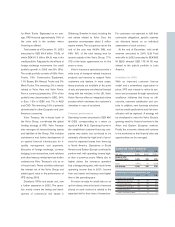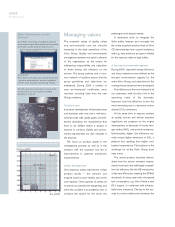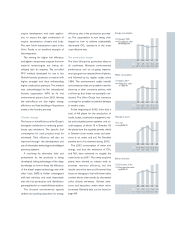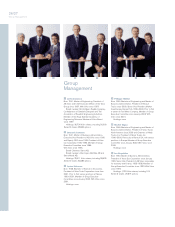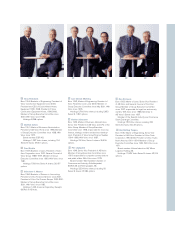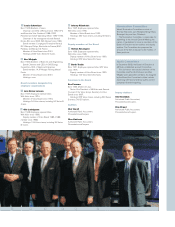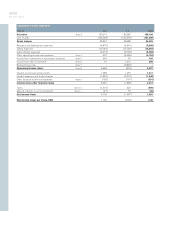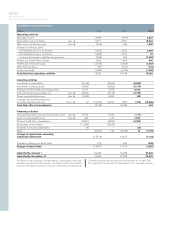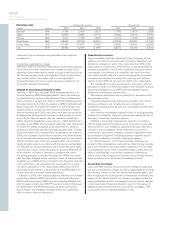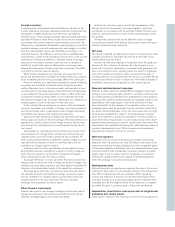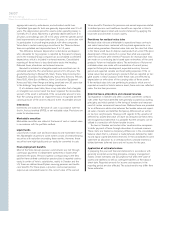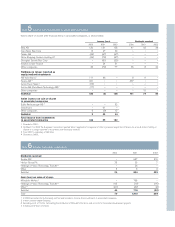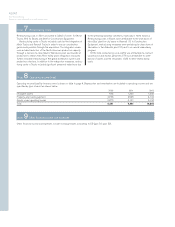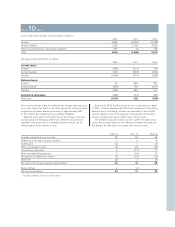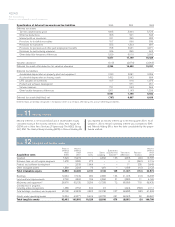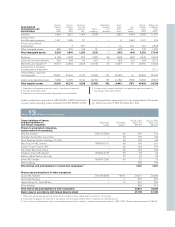Volvo 2002 Annual Report Download - page 35
Download and view the complete annual report
Please find page 35 of the 2002 Volvo annual report below. You can navigate through the pages in the report by either clicking on the pages listed below, or by using the keyword search tool below to find specific information within the annual report.
In applying the transition rules as a consequence of the afore-
mentioned accounting standards, there were no retroactive effects
on Volvo’s earlier financial statements. In applying the new standards
during fiscal year 2001, RR1:00 Consolidated Financial Statements
and Business Combinations, RR14 Joint Ventures, RR15 Intangible
Assets, RR16 Provisions, Contingent Liabilities and Contingent
Assets resulted in a change in Volvo’s accounting principles.
RR1:00 Consolidated Financial Statements
and Business Combinations
In accordance with RR1:00 Consolidated Financial Statements and
Business combinations, when a subsidiary is acquired through the
issue of own shares, the purchase consideration is determined to the
market price of the issued shares at the time of the transaction. In
accordance with Volvo’s previous accounting principles, such a pur-
chase consideration was determined based on the average market
price of the issued shares during ten days prior to the public disclos-
ure of the transaction.
RR14 Joint Ventures
In accordance with RR14 Joint ventures, a joint venture should
either be reported by use of the proportionate consolidation method
or the equity method. Effective in 2001, the proportionate consolida-
tion method is the preferred method under Volvo’s accounting prin-
ciples. In previous years, all joint ventures have been reported by use
of the equity method.
RR15 Intangible Assets
In accordance with RR15 Intangible Assets, the expenditures for
development of new products, production and information systems
shall be reported as intangible assets if such expenditures with a
high degree of certainty will result in future financial benefits for the
company. The acquisition value for such intangible assets shall be
amortized over the estimated useful life of the assets. Volvo’s appli-
cation of the new rules means that very high demands are estab-
lished in order for these development expenditures to be reported as
assets. For example, it must be possible to prove the technical func-
tionality of a new product prior to this development being reported as
an asset. In normal cases, this means that expenditures are capital-
ized only during the industrialization phase of a product development
project. In accordance with Volvo’s previous accounting principles, all
costs for the development of new products, production and informa-
tion systems were expensed on a current basis.
RR16 Provisions, Contingent Liabilities
and Contingent Assets
In accordance with RR16 Provisions, Contingent Liabilities and
Contingent Assets, a provision for decided restructuring measures is
reported first when a detailed plan for the implementation of the
measures is complete and when this plan is communicated to those
who are affected. In accordance with Volvo’s previous accounting
principles, a provision for restructuring measures was reported in
Notes to consolidated financial statements
Amounts in SEK M unless otherwise specified. The amounts within parentheses refer to the two preceding years; the first figure is for 2001
and the second for 2000.
Note 1Accounting principles
Volvo’s operations
The Volvo Group’s operations are focused on transport solutions for
commercial use and include development, manufacturing and sales
of vehicles, machinery and power systems and also transport-related
services such as service adapted to customer requirements, finan-
cing, insurance and transport information systems. Volvo is, after the
acquisition of Renault V.I. and Mack Trucks at the beginning of 2001,
the world’s second largest manufacturer of heavy trucks and also
one of the world’s largest producers of heavy-diesel engines. Volvo is
also one of the world’s largest manufacturers of buses and construc-
tion equipment, a successful supplier of marine and industrial power
systems, and a key partner to the foremost companies in the aircraft
and aerospace industries.
Operating structure
As of 2002, the Volvo Group’s operations are organized in eight
business areas: Volvo Trucks, Renault Trucks, Mack Trucks, Buses,
Construction Equipment, Volvo Penta, Volvo Aero and Financial
Services. In addition to the eight business areas, there are other
operations consisting mainly of business units that are designed to
support the business areas’ operations. The business units include
Powertrain, Volvo IT, Logistics and Parts.
Each business area, except for Financial Services, has total
responsibility for its operating income, operating capital and operat-
ing cash-flow. The Financial Services business area has responsibility
for its net income and total balance sheet within certain restrictions
and principles that are established centrally. In Volvo’s external finan-
cial reporting, sales and operating income are reported by product
area. Operating income within the business units Powertrain and
Parts are distributed to the respective product areas.
The supervision and coordination of treasury and tax matters is
organized centrally to obtain the benefits of a Group-wide approach.
The legal structure of the Volvo Group is based on optimal handling
of treasury, tax and administrative matters and, accordingly, differs
from the operating structure.
The consolidated financial statements for AB Volvo (the Parent
Company) and its subsidiaries are prepared in accordance with
Swedish GAAP. These accounting principles differ in significant
respects from U.S. GAAP, see Note 33.
Changes in accounting principles
As of 2001, Volvo is applying the following new accounting stand-
ards issued by the Swedish Financial Accounting Standards Council:
RR1:00 Consolidated Financial Statements and Business
Combinations, RR12 Tangible Assets, RR13 Associates, RR14 Joint
Ventures, RR15 Intangible Assets, RR16 Provisions, Contingent
Liabilities and Contingent Assets, RR17 Impairment of Assets, RR18
Income Per Share, RR19, Discontinuing Operations and RR20
Interim Financial Reporting. All accounting standards conform in all
significant respects with the corresponding accounting standard
issued by the International Accounting Standards Committee (IASC).


